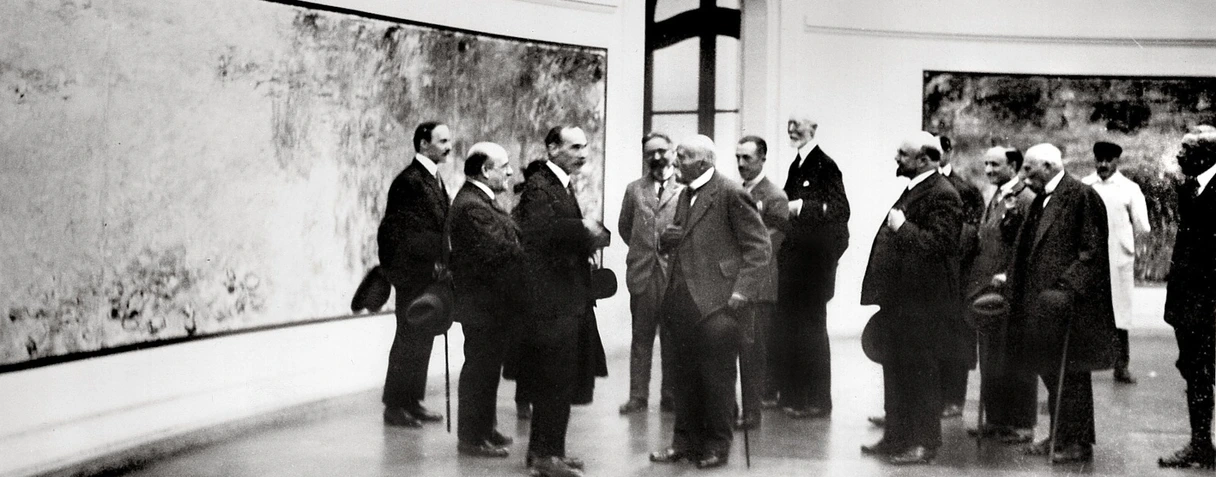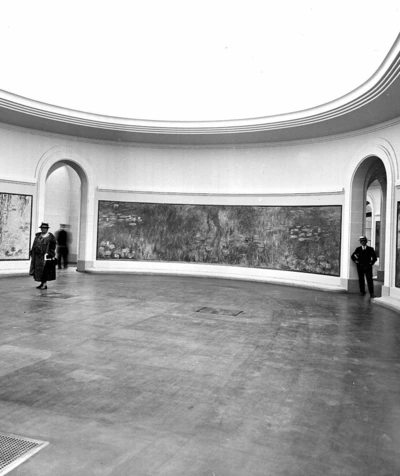Archives of the genesis and history of the Water Lilies
Archives of the genesis and history of the Water Lilies are kept by many different institutions, including in particular the French National Archives, where the document referenced “P-8 1922 Claude Monet” at the National Museum Archives is in fact the official deed whereby Monet's Water Lilies were donated to the French state, on 12 April, 1922. The Musée de l’Orangerie holds all the documents relating to the material history of the work following its installation in the building, as well as prints of numerous photographic campaigns. A series of photographs documents the damage caused by a shell during the battle for the Liberation of Paris on August 25, 1944, showing how some of the panels were altered.
A section of the museum’s library is dedicated to writings about the Water Lilies. It includes most of the key works on the subject, from Les Nymphéas by Georges Clemenceau, published by Plon in 1928 and the catalogue raisonné by Daniel Wildenstein in 1974, to Marianne Alphand’s 1993 biography, Une Vie dans le paysage [A Life in Landscape] and texts by Félicie Faizand de Maupeou, whose thesis was published in 2017, under the title Claude Monet et l’exposition. Une stratégie d’exposition à l’avènement du marché de l’art [Claude Monet and the exhibition. An exhibition strategy in response to the advent of the art market] , by the Rouen and Le Havre University Presses. Recently, the museum published the catalog for the 2018 exhibition entitled “The Water Lilies. American Abstract Painting and the last Monet”, and in 2019 there was a fresh publication of the correspondence between Monet and Clemenceau.
- Further reading:
The story of Monet’s Water Lilies series
- You can find out more about the chronology of the Water Lilies in the book: Les Nymphéas Monet [Monet’s Water Lilies], available in bookshops

The correspondence
When the Monet museum opened to the public on May 20, 1927, in the Orangerie building in the Tuileries Gardens, it was the final chapter of a story that had begun nearly 10 years earlier.
The discussions, work, and actual implementation of the project gave rise to considerable correspondence, between the artist, his close friend Georges Clemenceau, and the administration of the French society of Fine Arts (“Les Beaux Arts”) – these letters are now kept in various places (Clemenceau’s letters to Monet are all kept at the Manuscripts Department at the Bibliothèque Nationale de France), including the Musée de l’Orangerie.

©Musée de l'Orangerie / Patrice Schmidt
In 2011, twenty one letters were acquired at public auction.
This collection includes the letter to Clemenceau in which Monet accepts the Orangerie as a suitable exhibition space for his Water Lilies and offers to give the museum eighteen panels rather than twelve, seven letters from Paul Léon – then Director of Fine Arts –, four others written by art critic Arsène Alexandre and three from Henri Verne – National Museums Director at the time – as well as others from René Huyghe, curator at the Musée du Louvre, to Blanche Hoschédé-Monet, Claude Monet’s daughter-in-law.
In 2021, the purchase of two more letters further enriched this initial collection. The series sheds light on one of the most turbulent periods in the long genesis of the Water Lilies, when, in early 1925, Monet was thinking of changing his mind about donating his works to the French state as promised on November 12, 1918, the day after the Armistice.
This exchange of letters was the starting point of a period of intense tension in the difficult process of carrying out the project. The second letter was written on June 27, 1925, when the two men were renewing their friendship once more.

©Musée de l'Orangerie / Patrice Schmidt


